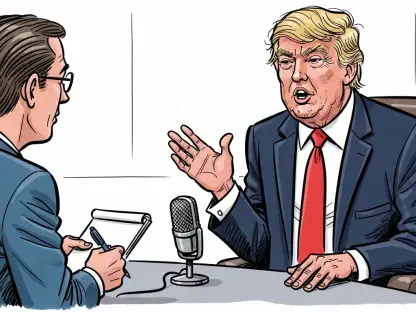In the complex world of tax policy, Donald Gainsborough stands out as a seasoned expert. As the leader of Government Curated, he provides insight into the new tax bill proposed by President Trump, a bill with significant implications for taxpayers and federal revenues. By diving into this interview, readers can uncover the nuances behind specific provisions, understand the potential outcomes of policy adjustments, and gain perspective on the evolving landscape of U.S. tax legislation.
Can you explain the key components of President Trump’s new tax bill?
The bill is designed around extending key elements of the 2017 tax cuts. It keeps personal income tax rates static while preserving the higher standard deduction that was nearly doubled back then. Some components are new and temporary but mostly maintain the status quo, intending to avoid significant changes in the taxes deducted from paychecks for now.
How does this bill differ from the 2017 tax cuts?
While the 2017 tax cuts introduced widespread changes, this bill is more focused on maintaining those changes over a longer period. The key difference is the introduction of new temporary cuts, such as the full deduction for tips and overtime, which were not part of the original 2017 legislation and mainly serve as targeted incentives.
What impacts might extending the current personal income tax rates have on taxpayers and federal revenues?
By locking in these rates, taxpayers won’t see an increase in what they owe at those income levels. However, this extension comes at a cost to federal revenues, estimated at a reduction of $2.2 trillion through 2034. It’s a balance of providing stability for taxpayers while addressing the long-term fiscal implications.
How do the changes to the standard deduction and personal exemptions affect taxpayers?
The current structure sees a boost in the standard deduction, which simplifies filing for many. At the same time, the elimination of personal exemptions seeks to streamline the system, ultimately bringing in an additional $1.9 trillion. This dual approach is intended to maintain a net revenue gain while offering some relief to taxpayers.
Could you describe the new provision regarding tips and overtime pay in the bill?
The provision allows for a full temporary deduction on tips and overtime pay, effectively eliminating taxes on these earnings. This is poised to reduce revenues by about $164 billion through 2028 but is intended to offer relief to those whose income heavily relies on these types of compensation.
What concerns have been raised by those in the restaurant industry regarding the tax break on tips?
A significant worry is that customers might feel less inclined to tip, knowing that their gratuities are tax-free income for the server. This could inadvertently reduce the earnings that tipped employees depend on, leading to concerns across the industry about how tipping behavior might change.
How might the no-tips tax rule create tensions between front-of-house and back-of-house staff?
There’s a potential for discord given that front-of-house staff benefit directly from the tax break, whereas back-of-house employees, who typically don’t earn tips, continue to pay taxes on their wages. This discrepancy could spark discontent over perceived inequalities within the same workplace.
What are the potential implications of the tax policy on taxpayers’ paperwork?
The policy could increase the complexity of tax filings for both employers and employees, depending on how the IRS interprets and implements the law. The need for accurate record-keeping around what is considered tax-free earnings might necessitate additional administrative efforts.
Can you detail the additional tax break for seniors and how it relates to Trump’s promises about Social Security?
The bill introduces a $4,000 tax break for seniors below a certain income, an indirect nod to Trump’s campaign promise to alleviate taxes on Social Security. However, due to legislative constraints like budget reconciliation, a direct alteration to Social Security taxation isn’t feasible.
Why can’t changes to Social Security be incorporated into this bill?
Current congressional rules limit alterations to Social Security through budget reconciliation, a process used to pass this tax bill on a party-line basis. This restricts the ability to directly change Social Security taxation as part of the overall budgetary package.
What is the current state of negotiations around the state and local tax (SALT) deduction cap?
Negotiations are still ongoing, with proposals ranging from a modest increase to a significant quadrupling of the current cap for certain incomes. These discussions reflect the contentious nature of the SALT cap, especially among representatives from high-tax states.
How might changes to the SALT cap affect taxpayers in high-tax states?
For residents of high-tax states, altering the SALT cap could markedly affect their overall tax bill. Lifting the cap would likely benefit these taxpayers, potentially offsetting the increased burden from state and local taxes they face compared to low-tax states.
Can you explain the interaction between the SALT cap and the alternative minimum tax (AMT)?
There are interesting dynamics at play here. Repealing the AMT while maintaining a SALT cap was initially beneficial, even for those in high taxation areas, as these individuals were less likely to meet the AMT threshold. It created a bizarre situation where the SALT cap wasn’t as detrimental due to the absence of AMT complications.
How have experts responded to the potential changes in the SALT cap?
Experts have varied responses, often based on regional biases. Blue-state analysts tend to favor the removal or easing of the cap, citing the disproportionate effects on their taxpayers. Others see it as a necessary component to balance the federal budget while acknowledging its complexity.
What is your forecast for this tax policy and its impact on the future?
If sustained, the policy could lead to a prolonged period of certainty for taxpayers but remains a contentious topic in fiscal debates. It balances between immediate taxpayer relief and long-term revenue implications, with future economic conditions likely necessitating further adjustments.









